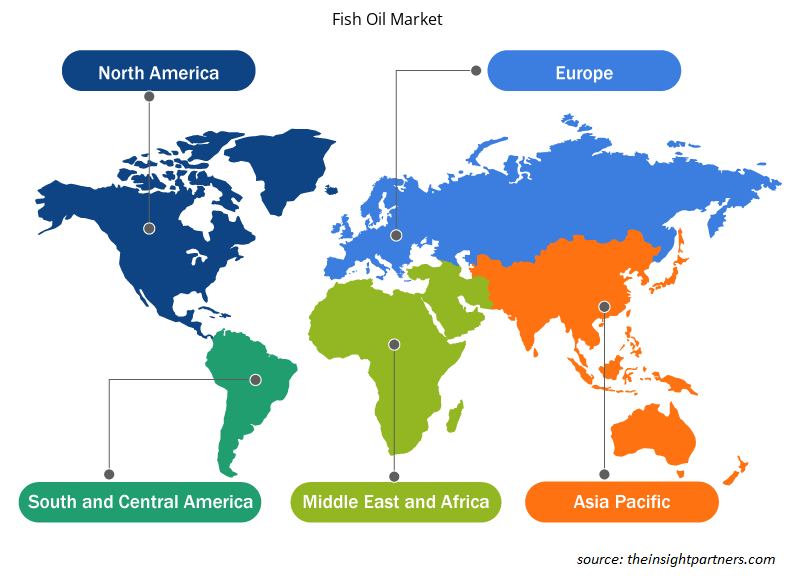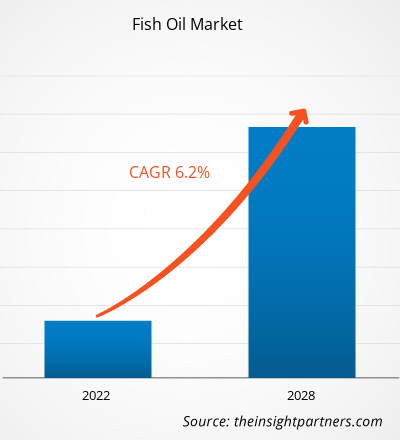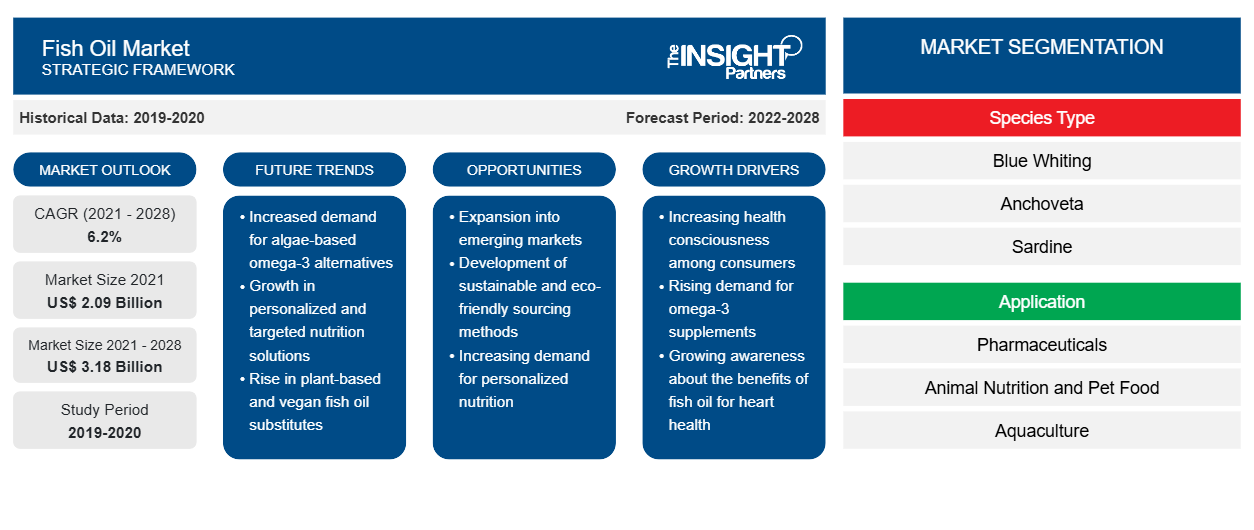Le marché de l'huile de poisson a été évalué à 2 087,39 millions de dollars américains en 2021 et devrait atteindre 3 178,28 millions de dollars américains d'ici 2028. Il devrait croître à un TCAC de 6,2 % de 2021 à 2028.
L'huile de poisson est issue de tissus de diverses espèces de poissons et contient des acides gras oméga-3, tels que les acides eicosapentaénoïques (EPA) et les acides docosahexaénoïques (DHA). Ils offrent divers avantages pour la santé, notamment une réduction du risque de décès dû à une crise cardiaque, à des rythmes cardiaques anormaux dangereux, à une diminution des triglycérides et à des accidents vasculaires cérébraux.
En 2020, l’Asie-Pacifique a dominé le marché mondial de l’huile de poisson et devrait conserver sa domination au cours de la période de prévision. La prise de conscience croissante liée aux bienfaits pour la santé et au riche profil nutritionnel de l’huile de poisson stimule la croissance du marché de l’huile de poisson dans toute la région. Parallèlement à cela, la prévalence accrue des maladies chroniques dans divers pays de la région entraîne une augmentation de la demande d’huile de poisson. Par exemple, en Australie, on estime que cinquante pour cent des Australiens souffrent d’au moins une des huit maladies chroniques courantes sélectionnées : cancer, maladie cardiovasculaire, problèmes de santé mentale, arthrite, maux de dos et problèmes, bronchopneumopathie chronique obstructive, asthme et diabète. Ces facteurs devraient favoriser la croissance de la demande d’huile de poisson dans la région.
Personnalisez ce rapport en fonction de vos besoins
Vous bénéficierez d'une personnalisation gratuite de n'importe quel rapport, y compris de certaines parties de ce rapport, d'une analyse au niveau des pays, d'un pack de données Excel, ainsi que d'offres et de remises exceptionnelles pour les start-ups et les universités.
-
Obtenez les principales tendances clés du marché de ce rapport.Cet échantillon GRATUIT comprendra une analyse de données, allant des tendances du marché aux estimations et prévisions.
Informations sur le marché
Large gamme d'applications de l'huile de poisson dans différentes industries
L'huile de poisson est de plus en plus utilisée dans diverses industries, telles que les produits pharmaceutiques, les compléments alimentaires , la nutrition animale et les aliments pour animaux de compagnie . Elle trouve une application importante dans les produits pharmaceutiques et est considérée comme une huile naturelle ou des concentrés d'EPA-DHA. Elle est également utilisée dans l'alimentation animale car elle a des effets favorisant la croissance et constitue une source d'énergie peu coûteuse. En dehors de cela, elle est également utilisée dans les aliments pour animaux de compagnie et aide à renforcer le système immunitaire des chiens tout en aidant à lutter contre le cancer canin. L'huile de poisson est également utilisée comme complément alimentaire où les capsules sont traditionnellement fabriquées à partir de gélatine qui recouvre l'huile dans les capsules molles. Ainsi, l'utilisation de l'huile de poisson dans différentes industries stimule la croissance du marché de l'huile de poisson.
Informations sur les types d'espèces
En fonction du type d'espèce, le marché de l'huile de poisson est divisé en merlan bleu, anchois, sardine, capelan et autres. En 2020, le segment de la sardine était le segment qui a connu la croissance la plus rapide du marché. La sardine est un petit poisson ressemblant au hareng et présentant divers avantages nutritionnels similaires à ceux d'autres poissons tels que le saumon. L'huile extraite de la sardine est également utilisée comme lubrifiant et est principalement utilisée dans les peintures, les vernis, les biocarburants et le linoléum.
Pesquera Exalmar SAA ; Omega Protein Corporation ; Pelagia AS ; Copeinca ; Coplex International SAC ; Triplenine ; FF Skagen A/S ; DSM ; Croda International PLC ; et BASF SE sont les principaux acteurs du marché de l'huile de poisson. Les principaux acteurs adoptent plusieurs stratégies, telles que les fusions et acquisitions et les lancements de produits, pour étendre leur présence géographique et leur base de consommateurs.
Rapports en vedette
- Tendances progressistes dans l'industrie de l'huile de poisson pour aider les acteurs à développer des stratégies efficaces à long terme
- Stratégies de croissance commerciale adoptées par les entreprises pour assurer leur croissance sur les marchés développés et en développement
- Analyse quantitative du marché mondial de l'huile de poisson de 2019 à 2028
- Estimation de la demande en huile de poisson dans diverses industries
- Analyse de Porter pour illustrer l'efficacité des acheteurs et des fournisseurs opérant dans l'industrie pour prédire la croissance du marché
- Développements récents pour comprendre le scénario concurrentiel du marché et la demande d'huile de poisson
- Tendances et perspectives du marché associées aux facteurs qui stimulent et freinent la croissance du marché de l'huile de poisson
- Compréhension des stratégies qui sous-tendent l'intérêt commercial à l'égard de la croissance du marché mondial de l'huile de poisson, aidant au processus de prise de décision
- Taille du marché de l'huile de poisson à différents points du marché
- Aperçu détaillé et segmentation du marché mondial de l'huile de poisson ainsi que de sa dynamique industrielle
- Taille du marché de l'huile de poisson dans diverses régions avec des opportunités de croissance prometteuses
Aperçu régional du marché de l'huile de poisson
Les tendances régionales et les facteurs influençant le marché de l’huile de poisson tout au long de la période de prévision ont été expliqués en détail par les analystes d’Insight Partners. Cette section traite également des segments et de la géographie du marché de l’huile de poisson en Amérique du Nord, en Europe, en Asie-Pacifique, au Moyen-Orient et en Afrique, ainsi qu’en Amérique du Sud et en Amérique centrale.

- Obtenez les données régionales spécifiques au marché de l'huile de poisson
Portée du rapport sur le marché de l'huile de poisson
| Attribut de rapport | Détails |
|---|---|
| Taille du marché en 2021 | 2,09 milliards de dollars américains |
| Taille du marché d'ici 2028 | 3,18 milliards de dollars américains |
| Taux de croissance annuel moyen mondial (2021-2028) | 6,2% |
| Données historiques | 2019-2020 |
| Période de prévision | 2022-2028 |
| Segments couverts |
Par type d'espèce
|
| Régions et pays couverts |
Amérique du Nord
|
| Leaders du marché et profils d'entreprises clés |
|
Densité des acteurs du marché de l'huile de poisson : comprendre son impact sur la dynamique des entreprises
Le marché de l'huile de poisson connaît une croissance rapide, tirée par la demande croissante des utilisateurs finaux en raison de facteurs tels que l'évolution des préférences des consommateurs, les avancées technologiques et une plus grande sensibilisation aux avantages du produit. À mesure que la demande augmente, les entreprises élargissent leurs offres, innovent pour répondre aux besoins des consommateurs et capitalisent sur les tendances émergentes, ce qui alimente davantage la croissance du marché.
La densité des acteurs du marché fait référence à la répartition des entreprises ou des sociétés opérant sur un marché ou un secteur particulier. Elle indique le nombre de concurrents (acteurs du marché) présents sur un marché donné par rapport à sa taille ou à sa valeur marchande totale.
Les principales entreprises opérant sur le marché de l'huile de poisson sont :
- Pêche Exalmar SAA
- SOCIÉTÉ DE PROTÉINES OMEGA
- PÉLAGIE COMME
- COPEINCA
- COPLEX INTERNATIONAL SAC
Avis de non-responsabilité : les sociétés répertoriées ci-dessus ne sont pas classées dans un ordre particulier.

- Obtenez un aperçu des principaux acteurs du marché de l'huile de poisson
L'analyse du marché mondial de l'huile de poisson jusqu'en 2028 est une étude spécialisée et approfondie de l'industrie des aliments et des boissons, avec un accent particulier sur l'analyse des tendances du marché mondial de l'huile de poisson. Le rapport vise à fournir un aperçu du marché avec une segmentation détaillée du marché. Le marché de l'huile de poisson est analysé sur trois fronts : le type d'espèce, l'application et la géographie. En fonction du type d'espèce, le marché est divisé en merlan bleu, anchois, sardine, capelan et autres. En fonction de l'application, le marché de l'huile de poisson est divisé en produits pharmaceutiques, nutrition animale et aliments pour animaux de compagnie, aquaculture, compléments alimentaires et autres. En fonction de la géographie, le marché de l'huile de poisson est segmenté en cinq régions principales : l'Amérique du Nord, l'Europe, l'Asie-Pacifique, le Moyen-Orient et l'Afrique, et l'Amérique du Sud et l'Amérique centrale.
Profils d'entreprise
- BASF SE
- Copeinça
- Coplex International SAC
- Croda International PLC
- DSM
- FF Skagen A/S
- Société de protéines Omega
- Pélagie AS
- Pêcheur Exalmar SAA
- Triplenine
- Analyse historique (2 ans), année de base, prévision (7 ans) avec TCAC
- Analyse PEST et SWOT
- Taille du marché Valeur / Volume - Mondial, Régional, Pays
- Industrie et paysage concurrentiel
- Ensemble de données Excel
Rapports récents
Rapports connexes
Témoignages
Raison d'acheter
- Prise de décision éclairée
- Compréhension de la dynamique du marché
- Analyse concurrentielle
- Connaissances clients
- Prévisions de marché
- Atténuation des risques
- Planification stratégique
- Justification des investissements
- Identification des marchés émergents
- Amélioration des stratégies marketing
- Amélioration de l'efficacité opérationnelle
- Alignement sur les tendances réglementaires























 Obtenez un échantillon gratuit pour - Marché de l'huile de poisson
Obtenez un échantillon gratuit pour - Marché de l'huile de poisson